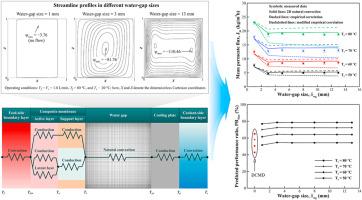水隙膜蒸馏详细建模和模拟的新方法:建立数值基准模型
IF 8.4
1区 工程技术
Q1 ENGINEERING, CHEMICAL
引用次数: 0
摘要
在水隙膜蒸馏(WGMD)中,水隙内的自然对流对性能和热效率有很大影响。以往的研究使用经验或修正的经验相关模型来预测水隙内的努塞尔特数,研究自然对流如何影响 WGMD 的性能和热效率。然而,这些模型只针对特定的运行条件,限制了它们在开发 WGMD 过程综合数值模型中的应用。为了解决这一局限性,我们在水隙中集成了一个二维自然对流模型,从而开发了一个数值模型。我们在广泛的进料温度和水隙尺寸范围内进行了实验研究,以评估关键操作参数对性能的影响。为了验证所提数值模型的有效性,将实验结果与所提模型的结果以及以往研究中使用的数值模型的结果进行了比较。拟议的数值模型与测量数据的最大偏差为 8.5%,而之前研究中使用的数值模型的偏差为 22.9%。此外,还通过等温线和流线分析了水隙内的流动特性,并探讨了与直接接触膜蒸馏(DCMD)相比,WGMD 所提高的热效率。本文章由计算机程序翻译,如有差异,请以英文原文为准。

A novel approach to detailed modeling and simulation of water-gap membrane distillation: Establishing a numerical baseline model
In water-gap membrane distillation (WGMD), natural convection within the water gap significantly impacts performance and thermal efficiency. Previous studies have used empirical or modified empirical correlation models to predict the Nusselt number within the water gap, investigating how natural convection affects WGMD performance and thermal efficiency. However, these models are specific to certain operating conditions, limiting their application in developing a comprehensive numerical model for the WGMD process. To address this limitation, we developed a numerical model by integrating a two-dimensional natural convection model within the water gap. Experimental investigations were conducted across a wide range of feed temperatures and water gap sizes to assess the influence of key operating parameters on performance. To validate the effectiveness of the proposed numerical model, the experimental results were compared with those from the proposed model and with results from numerical models used in previous studies. The proposed numerical model demonstrated a maximum deviation of 8.5 % from the measured data, whereas the numerical models used in previous studies exhibited deviations of 22.9 %. In addition, the flow characteristics within the water gap were analyzed through isotherms and streamlines, and the improved thermal efficiency of WGMD compared to direct contact membrane distillation (DCMD) was explored.
求助全文
通过发布文献求助,成功后即可免费获取论文全文。
去求助
来源期刊

Journal of Membrane Science
工程技术-高分子科学
CiteScore
17.10
自引率
17.90%
发文量
1031
审稿时长
2.5 months
期刊介绍:
The Journal of Membrane Science is a publication that focuses on membrane systems and is aimed at academic and industrial chemists, chemical engineers, materials scientists, and membranologists. It publishes original research and reviews on various aspects of membrane transport, membrane formation/structure, fouling, module/process design, and processes/applications. The journal primarily focuses on the structure, function, and performance of non-biological membranes but also includes papers that relate to biological membranes. The Journal of Membrane Science publishes Full Text Papers, State-of-the-Art Reviews, Letters to the Editor, and Perspectives.
 求助内容:
求助内容: 应助结果提醒方式:
应助结果提醒方式:


